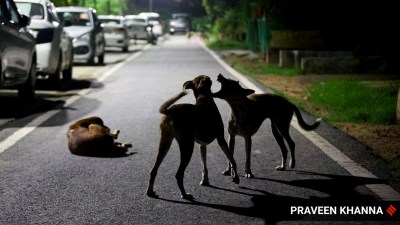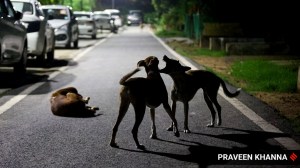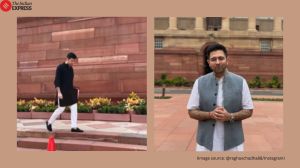Stay updated with the latest - Click here to follow us on Instagram
IIT Delhi study on odd-even phase I: Average speeds fell in morning peak hours, early start seen as key factor
The study found that average speeds decreased by 5 per cent in arterial road segments, 4 per cent in ring road segments, 3 per cent in commercial roads and by 1 per cent in inter-city roads during the first phase of the scheme between January 1 and 15.
 The average speeds, however, increased during the peak traffic hours in the evening. Ravi Kanojia
The average speeds, however, increased during the peak traffic hours in the evening. Ravi Kanojia
Average speeds across four categories of roads — arterial, commercial, inter-city and ring roads — decreased “by a small amount” during peak traffic hours of 8-11 am during the first phase of Delhi’s odd-even scheme in comparison to four days before it began, according to initial findings of an IIT Delhi study.
The study found that average speeds decreased by 5 per cent in arterial road segments, 4 per cent in ring road segments, 3 per cent in commercial roads and by 1 per cent in inter-city roads during the first phase of the scheme between January 1 and 15.
“We believe a lot of people started their journey earlier in the day, around 7-7.30 am, to beat the start of the odd-even rule at 8 am, and the traffic spilled over to the 8-11 am period. A lot of the congestion shifted to the evening and later evening. During the afternoon,we saw the maximum hikes in speed of vehicles,” said Dr Dinesh Mohan, emeritus professor with the Transportation Research and Injury Prevention Programme (TRIPP) at IIT Delhi.
Watch video Odd-Even Phase II Scheme: Ex-Servicemen March In Unison For Odd-Even Role
The average speeds, however, increased during the peak traffic hours in the evening between 5 and 8 pm by 9, 6, 9 and 3 per cent, respectively, in the same road categories. Between 11 am and 5 pm, speeds increased by 6, 7, 6 and 5 per cent, respectively, across the road categories.
Dr Geetam Tiwari, TRIPP chair professor at IIT Delhi said, “Mornings and evenings are work trips, so possibly people could not afford to put off those trips. During the afternoons, trips are usually discretionary and it could be that people chose to put them off. The bulk of the traffic in afternoons is from school buses and since schools were closed during the scheme it could be that it helped matters.” Schools were closed even during the period before the odd-even scheme included in the study.
According to IIT Delhi scientists, the increase in speeds — a maximum of 9 per cent and an average of around 5 per cent — is “marginal”. Dr Mohan said, “The maximum hikes in speed and reduction in congestion was seen in south Delhi, possibly because people with a higher socio-economic status were able to afford other means. Anyway, only a very small increase in speed was observed.”
The study gathered data on traffic speed from Google Maps Distance Matrix API along 14 stretches of arterial roads, including Aurobindo Marg and August Kranti Marg, six inter-city roads linking Delhi to Ghaziabad and Gurgaon, eight stretches of commercial roads along office or market complexes in Connaught Place and Ashoka Road, and eight areas in outer ring road and the ring road in Nehru Place, near AIIMS and IIT gate, among others.
Scientists also studied proportion of odd and even numbered cars on the roads, occupancy of cars, and the volume of cars, two-wheelers, three-wheelers and buses. Data on all parameters were compared with the data gathered over four days before the scheme, and six days after the scheme.
Scientists carried out surveys, video recording vehicles on roads at Jia Sarai on outer ring road, South Extension on ring road, Sai Mandir at Khel Gaon Marg, and Income Tax Office on Vikas Marg.
Manual observation to study the compliance of the odd-even rule, where 200 cars were studied at every location, revealed about 24 per cent even numbered cars were on roads during odd days and 23 per cent odd numbered cars were in operation during even days.
“This shows that on any given day about 30 per cent vehicles without the appropriate number plates were on the road. This could be due to exemptions… and partially due to non-compliance. But the assumption that odd-even would immediately take 50 per cent of the cars off the road has not been fulfilled,” said Dr Mohan.
Rise in volume of other vehicles
“While the car flow came down in all the locations, this reduction was accompanied by a near simultaneous spike in two-wheelers, three-wheelers and buses. The sharpest increase was seen in two-wheelers,” said Dr Tiwari. The three-wheeler flow was found to have increased by 25, 12 and 12 per cent, respectively at Sai Mandir, ITO and Jia Sarai, and decreased by 2 per cent at South Extension. The bus flow per hour increased by 16, 11 and 5 per cent at Sai Mandir, ITO and South Extension, respectively. At Jia Sarai, bus flow decreased by 5 per cent.
According to IIT scientists, this does not necessarily mean good news. “The increase in two-wheelers, besides adding to emissions, also results in an additional risk of accidents. Three-wheelers and buses, despite running on CNG do contribute to emissions and therefore it is tough to say without more concrete data whether the odd-even scheme results in any significant impact on emissions,” explained Dr Mohan.
Scientists said there was no “significant” increase in Metro ridership that could be attributed to the scheme.







